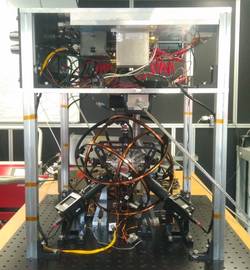Student Experiments with Cold Atoms for Multiple Platforms (SECAMP)

The SECAMP project (Student Experiments with Cold Atoms for Multiple Platforms) gives students hands-on experience with cold atoms. The project heritages from the results and experience made by MAIUS-I and is funded through the Christa-und-Manfred-Fuchs-Stiftungsprofessur. SECAMP underlines the self-conception of the University of Bremen as a university of research-based learning and enables students from various technical disciplines to gain access to the physically influenced subject area of cold atoms and quantum sensors. In that way ZARM trains next-generation engineers in an interdisciplinary way.
Measuring inertial forces with cold atoms is a promising technology with a broad manifold of applications such as fundamental physics, metrology, space, civil engineering and inertial navigation. In the framework of SECAMP a mechanical concept for a relatively simple, compact and lightweight magneto-optical trap (MOT) was presented in 2018 and the development is ongoing since. The experiment was designed in such a way it can be operated on a REXUS sounding rocket, the drop tower Bremen, a zeroG aircraft or a centrifuge. The SECAMP MOT is designed for Rubidium-87 as atomic species and uses macroscopic coils for cooling and confinement of the atomic cloud. Furthermore, the apparatus is equipped with an imaging system to detect the movement of the atomic cloud due to external accelerations based on fluorescence imaging. The vacuum inside the UHV-chamber is ensured by an ion-getter-pump resulting in a residual pressure of 10^-8 mbar. It is noteworthy that for the SECAMP project almost only components of the shelf (COTS) were used, reducing cost and development effort. In the course of SECAMP also the feasibility of the sensor to be used as a three axis accelerometer based on atom interferometry was investigated in 2020.
Another goal of SECAMP is to serve as a technology development platform and test bed for the miniaturization of relevant equipment and shall pave the way to move quantum sensors based on cold atoms out of the laboratory to be used in the field.


 "
"